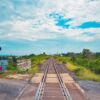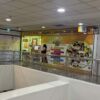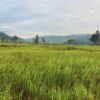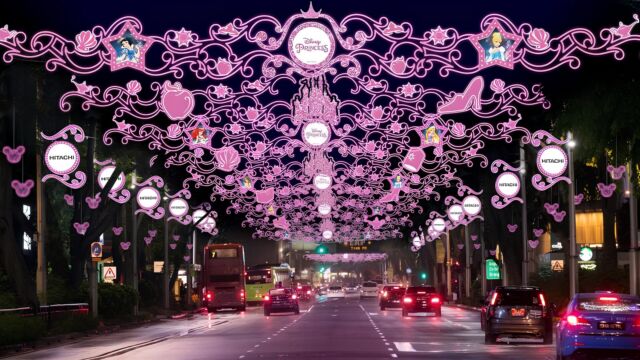Nightjarred at the Waterworks
Photo: Stephanie Dogfoot
“The Waterworks” | 1,773 words
Breathing space. That’s how I like to think of it. It’s a field – a strip of grass, really, around the corner from my house. Just a few kilometers long and maybe 100 meters wide, buffering Bukit Timah Nature Reserve, and flanking the Bukit Timah Expressway and a couple of condo developments. A pipeline runs beneath it, probably the only reason why it hasn’t been developed. Above ground, there are old tree roots, cement manholes, grasses of uneven heights, the smell of soil, a dirt trail made either by or for mountain bikers, and a constant sense that a place like this should not exist in a place like Singapore.
I come here mostly with my dog, a tricolor Pembroke Welsh Corgi named Olive. She is nine years old and loves the idea of being outdoors, but not always the reality of it. Still, I take her when I can and take her leash off just to watch her bounce through the grass and sprint/tumble downhill and explore as far as her small legs will take her, until she gets tired or finds something muddy and foul to roll in, whichever comes first. We are often the only ones here, except for the occasional jogger or mountain biker, or some evenings, other dogs and their owners.
There is something delicious about stepping onto an open field of grass knowing it goes on for miles, knowing you can keep walking for ages and not stop. Fields are not a thing you expect to find in Singapore, especially not fields which are open to the public and free to roam in. Singapore is not the kind of place that encourages random open spaces. Or the kind of barely-marked paths and disorder you find here—the fallen logs, tall grasses, the occasional puddles of mud after rain. “Wild” is a word that comes to mind, but would not be entirely accurate—there are still workers riding lawn mowers that keep the grass trimmed. There are signs reminding you that you are on government-owned nature with a pipeline below, and to mind your step so you don’t fall over or into anything. You won’t find this place in a tourist brochure or park guide though—I don’t think it even has an official name.
For as long as I can remember, my family and I have called it the Waterworks. It’s not entirely accurate, or inaccurate. It is, after all, around the corner from an actual water treatment plant, Chestnut Avenue Waterworks, and the pipeline is used to transport water there.
I don’t remember the first time I came here, but I grew up in this area and I have been riding the Bukit Timah Mountain Bike Trail since I was nine and my dad brought me out. I think our family started coming here with my first puppy, a red Pembroke Welsh Corgi named Keegan. It was 2001. I was 14 then, had just spent two years preparing and researching dog care and training, and was dreaming—literally. I had always loved dogs and was semi-obsessed with learning about dog breeds as a kid, but it was when I woke up one morning when I was 12 after an intense dream about owning one that I found myself single-mindedly fixated on the idea of having a dog, a fixation that would not rest until I was taking a puppy home.
At some point, it became a family tradition to go to the Waterworks with Keegan on weekend evenings, take off his leash and let him run wildly through the grass, and walk, often without seeing anyone, for several hours, feeling like we were on a walk on a family holiday in another country somewhere else in the world with green open space, where it was common to find fields and forests—and not in Singapore, and definitely not a two-minute drive from our house. Watching our little dog take off and dash through the grass, turning back to look at us for a split second with a wicked glint in his eye (we called this his evil eye), and getting to share in his simple bliss and freedom, I realized this was what owning a dog was about—being able to bring joy to another living thing and catch even the briefest glimpse of that pure, unadulterated joy. And I could not imagine that happening anywhere else.

Perhaps I bring our current corgi, Olive, to the Waterworks in the hopes of recreating the way this place used to make me feel when I brought Keegan here as a teenager—the same feeling of damp grass below my feet, of cicada and nightjar call in the surrounding trees, a feeling of peace, of freedom, of “yes, this place is mine”, of “why would I ever need to be anywhere else?” A feeling of “yes, this is enough”, that perhaps if a small forgotten patch of grass could make me happy, happiness was not a hard problem to solve. Of course, when I walked my first dog here in the early 2000s, I knew very little of the world and what it had to offer—I knew of countries with much wilder, much greener spaces than this, countries whose green spaces could not disappear overnight, whose fates were not bound to a flick of a government planner’s pen. I knew nothing of what it meant to live in another country, to love another piece of land as much, if not more than this one.
But after eight years of living in other places, nowhere felt quite as much mine as here. No place I loved ever felt as much mine as the Waterworks. Whenever I thought of home I thought of mud, of wildflowers, of lovegrass and lallang, of a galloping corgi. I told people I missed the tropics. I missed Singapore’s rainforests and in-between green spaces like this one that exist in spite of everything, the year-round greenness, rich with plant and animal life, sounds and insects, the soft crunch of moist grass and leaves beneath my sandals.
Or maybe it’s my constant nostalgia for places like this and the need to romanticize and cling onto the past that’s stopped me from trying harder to keep living overseas, from finding a country elsewhere where I could be even happier, from moving out of my parents’ house.
Keegan passed away in 2010, after a battle with lupus and various other conditions. Our current corgi, Olive, is almost the same age that he was when he died. I keep reminding myself that she is a different dog entirely. She is not the kind of dog to dash around when I take off her leash. She prefers to amble along and sniff the ground every few steps. She doesn’t run away with an evil eye. She sprints for a hundred meters or so then lies down on the grass, smiling and panting. After half an hour she refuses to move ahead entirely, her signal that she wants to go home, even as I try to coax her to walk—there is so much more of the Waterworks to explore, that I want to see. I realize it’s unrealistic to expect an older dog to behave like my idealized memory of a puppy I once had. Olive shows me that there is more than one way to savor a space. That I don’t need to walk or run the whole length of the Waterworks today, there is appreciation and things to discover while being still. I sigh and pour some water out for her. A breeze blows by. A middle-aged walker smiles at Olive as he walks by. Cicadas have started singing in a new key.
A rustle above—I instinctively jerk to put her leash back on. Olive’s ears stand to attention. A long-tailed macaque is watching us from a nearby tree. This must mean a troop is nearby. It seems like there’s more monkeys by the Waterworks now compared to twenty years ago. Perhaps this is another reason why Olive is eager to leave. At home, roving troops of macaques pass through our garden and she is on constant alert (corgis are, after all, herding dogs who take their jobs very seriously), always itching to go crazy barking at any potentially invading monkeys until they are driven away, either by intimidation or sheer irritation. Here, though, it seems like she understands that she is in the monkeys’ territory and is not quite welcome. Perhaps the troops have shared information about Olive and they don’t trust her.
There are also more wild boars here than ever before. They were virtually unheard of in 2001, but now several of them make their home in the forests around the Waterworks. Their population has been steadily increasing since the 90s: some believe that more have swum across the strait from Johor ever since the state started clearing more forests for development. There have been stories of boars injuring people, of culls, plans to build a fence around the forests. I see them sometimes on my walks here. We always have a split second where we hold eye contact, then I fumble for my phone to take a picture and they leap back into the forest.


Some time in 2004 I was cycling through the Waterworks when I swerved to avoid a small log in my way. To my surprise, instead of behaving like a log would, the log sprouted wings and flew away. It wasn’t a log at all—it was a brown nightjar. I still consider that one of the most magical experiences of my teen years. I even made up a word for it—nightjarred, a feeling of total exhilaration and wonder.
Maybe that sums up how I feel about the Waterworks and why I keep coming back. It’s funny how what I liked most about it was how it felt like being outside of Singapore—when it could not exist anywhere else. When it’s what I used to think of when I thought of Singapore, when I thought of home. I might still never have an answer for why I keep coming back, if it was really worth it returning to Singapore, to let myself be content with tiny patches of grass that haven’t been developed into condos yet when there is a whole world out there. What I do know is the smile on my dog’s face as we bundle into the car, the mud on the soles of my sandals, the mosquito bites, the nightjar and frog chorus, the knowledge that, for now at least, I have a place to breathe.
© Stephanie Dogfoot
Commissioning editor: Verena Tay






